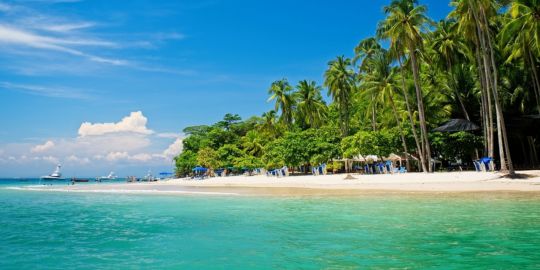Travelling to Costa Rica

Located between Nicaragua and Panama, millions of foreigners travel to the 'Switzerland of Central America' every year for its picture-postcard beaches, tropical jungles and adventure activities. Read this article to find out more.
Thanks to its developed infrastructure, political stability, peaceful atmosphere, pleasant climate and plethora of protected areas, Costa Rica remains a popular place to visit in Central America. Violent crime is minimal, and there are more Americans living in Costa Rica per capita than in any other country.
So long as you have a valid passport and an onward flight or bus ticket, North American and most European citizens are permitted to visit Costa Rica as tourists for up to 90 days. If you're travelling on your own with a minor, you should be prepared to provide specific paperwork to be allowed out of the country.
Do note that you will be required to pay a departure tax of US$28 when you exit the country by air, but this is waived if you leave the country by sea or overland. This exit fee is payable by credit card, debit card, or cash (US Dollars or Costa Rican Colones) at the airport, and if you are leaving from Juan Santamaria International Airport, you will need to pay your departure tax before checking in for your flight.
Getting there
Costa Rica has two international airports ' Juan Santamaria International Airport (SJO) and Daniel Oduber Quiros International Airport (LIR) ' and both are reached by many airlines. However, most international flights go through SJO, which is located in Alajuela, about half an hour from the capital of San José, wheres LIR is located in Liberia, in Guanacaste province.
As a general rule, flight tickets are more expensive during the high season from December to April, and peak around major holidays, such as Christmas, New Year and Easter. If you're looking for lower fares, consider travelling mid-week and be willing to be flexible with your travel dates. Tickets tend to be more expensive on Fridays and Saturdays, and cheapest on Tuesdays and Wednesdays.
If you travel to Costa Rica during its low season, between May and November, you may be able to find some fantastic last-minute deals. There are plenty of bargains in store for those who are happy to visit during these 'green season' months, and you could stand to save around 30% on accommodation, as well as enjoy the country without the crowds.
There are also several international buses, such as Sirca, Trans Nica, Tica Bus and Tracopa, that travel between San José and both Nicaragua and Panama, as well other Central American countries.
Vaccinations
When travelling to Costa Rica, there are no mandatory vaccinations, but it's highly recommended that you are up-to-date with all routine immunisations, such as the DPT and MMR vaccines, as well as hepatitis A, hepatitis B, typhoid and varicella (chicken pox), especially if you plan to stay in Costa Rica for more than six months.
If you are travelling from certain African countries (Angola, Benin, Burkina Faso, Cameroon, Democratic Republic of Congo, Gabon, Gambia, Guinea, Liberia, Nigeria, Sierra Leone, and Sudan) or South American countries (Bolivia, Brazil, Venezuela, Peru, Columbia, Ecuador, and Guyana), you will also need to have a valid yellow fever vaccination certificate that you can show on arrival.
Before travelling to Costa Rica, it's advisable to consult your doctor as to which vaccinations, booster shots or medications you may require.
What to bring
If you're planning on travelling in Costa Rica's more tropical areas, then you should bring a pair of long trousers and a long sleeve shirt in addition to your beach gear. There's no need to overpack when travelling to Costa Rica, as most hotels and hostels offer a laundry service for a nominal fee, and you can buy almost any item in a local store (albeit they may carry a higher price tag due to import taxes). It's also worth bearing in mind that, if you are taking a domestic flight, the regional airlines tend to have strict baggage weight limits.
Drugs, explosives, used tyres, and subversive material are all prohibited. People over the age of 18 are allowed to bring in up to 2kg of sweets, 500g of tobacco, and five litres of alcohol for personal use into Costa Rica duty-free. If you wish to bring more than that amount, it will be considered a commercial import and be subject to duty that can range between 103% and 135% of the market value. You will also require an alcoholic beverage import permit or your merchandise will be stored at a customs warehouse.
Money
Costa Rica's official currency is the colon (CRC), and its symbol is â¡. However, American dollars (USD) are widely accepted as well (preferably US$20 bills and less). You can purchase small items at many stores with a US$5, US$10 or US$20 bill, and you will likely be given colones as change. You can often even pay for taxi fares, hotel accommodation, park entrance fees, tours and meals at tourist restaurants with dollars. However, if you wish to eat a meal at a local market or ride a public bus, it's best to pay with colones.
Although many small money-changers on street corners will exchange U.S. Dollars and travellers cheques, you can get better rates by simply withdrawing cash in colones from an ATM (many ATMs also dispense U.S. dollars too). There is at least one ATM in even the smallest towns in the country, and most machines operate on the Visa Plus network, but those on the Cirrus network also accept most foreign debit and credit cards.
You can use your credit card (Visa, Mastercard and American Express are widely accepted) in supermarkets, car rental agencies, department stores, petrol stations, and upmarket hotels and restaurants in tourist towns, but you may be charged a transaction fee on all international credit card purchases. However, small stores and restaurants ' especially those in rural areas ' are less likely to accept this form of payment.
You can also get cash from a bank using a credit card, but be prepared that your credit card company could charge you a fee of up to 10%. All government-owned or private banks will also exchange U.S. Dollars, and some will exchange British Pounds and Euros, so long as the bills aren't damaged in any way. You will just need to bring your passport and a bit of patience if you wish to change money at a Banco Nacional, Banco Popular or Banco de Costa Rica, as state-run banks are known to offer quite a slow service. However, private banks, such as BANEX, Scotiabank, or Banco Mercantil tend to offer faster service and have English-speaking tellers. Most state banks are open from 9 am to 3:30 pm, Monday to Friday, while private banks are usually open from 8 am to 4 pm on the same days.
Although the Global Exchange office is open daily from 5 am to midnight in Juan Santamaria International Airport, it's not advisable to change money there if you can avoid it, as you'll get a much lower rate there than at a bank.
If you are travelling to Costa Rica on a budget, it's best to allow an extra US$25 a day for miscellaneous expenses, as ATM fees, hotel service charges, taxes and tips can easily add up if you haven't accounted for them. If you are on a tight budget, be sure to verify all inclusions, such as taxes and breakfasts, in packages, and enquire as to whether room rates are per night or per person before you commit to anything.
Useful links:
Expat.com ' Formalities in Costa Rica Forum
Migration Department www.migracion.go.cr
Embassy of Costa Rica in the US www.costarica-embassy.org
Embassy of Costa Rica in Canada www.costaricaembassy.com
Government of UK ' Travel advice www.gov.uk









